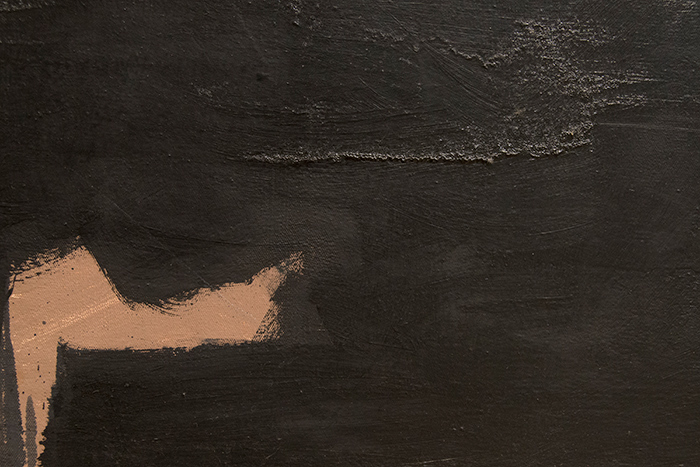Posted on Wed., Aug. 10, 2016 by

Emerson Woelffer’s Yellow Poem, 1960, oil on canvas. Gift of Adam Mekler in honor of Ariel Gabriella Mekler and Daphne Lane Beneke. The Huntington Library, Art Collections, and Botanical Gardens. Photo by Kate Lain.
As construction winds down in the Virginia Steele Scott Galleries of American Art, many works from The Huntington’s permanent collection are once again on display. Among these works are a few new additions. Thanks to the generosity of Adam Mekler, one of the new paintings is the work of a hugely influential and prolific abstract artist: Emerson Woelffer (1914–2003).
Those unfamiliar with Woelffer’s career may find his painting Yellow Poem (1960) a bit modest in appearance, at first glance, for an artist once dubbed “The Grandfather of L.A. Modernism.” But by the 1960s, Woelffer had already spent 30 years creating paintings, lithographs, and collages with a single-minded dedication to Abstract Expressionism.

Detail from Woelffer’s Yellow Poem. The Huntington Library, Art Collections, and Botanical Gardens. Photo by Kate Lain.
Born in Chicago, Woelffer studied at the Art Institute of Chicago, worked for the Works Project Administration (WPA), taught at Black Mountain College and the Colorado Springs Fine Arts Center, and traveled abroad to paint—primarily in Mexico and Italy—before moving to Los Angeles in 1960. In L.A., he participated in West Coast Abstraction and taught at the Chouinard Art Institute (now CalArts) and the Otis Art Institute (now the Otis College of Art and Design). Notable students of his included Joe Goode and Ed Ruscha.
Yellow Poem marks a significant evolution in Woelffer’s artistic style. His early works featured eerily abstract and energetic figures—a marriage of his interests in the contemporary Abstract Expressionism movement and Chicago’s jazz scene. After moving from Chicago to teach at Black Mountain College and Colorado Springs, Woelffer became preoccupied with simple forms and their movements—like those of birds.

Detail from Woelffer’s Yellow Poem. The Huntington Library, Art Collections, and Botanical Gardens. Photo by Kate Lain.
Over time, his composition became more and more refined. In Yellow Poem, rhythmical characteristics apparent in his previous works still remain: in the white paint haphazardly smeared on the canvas surface, the jagged edges of the black expanse, the paint “dripping” out of frame, and the single yellow bar lining the top. But the actors in this piece are no longer figures found in nature. The main actor is the paint itself, and the painting allows viewers a glimpse into a place just beyond the cusp of articulation.
Woelffer was fond of declaring, as he did in a 1976 oral history with Joann Phillips, “I paint first and think afterwards.” Later, in a 1992 exhibition catalog, he went a step further: “I want to delete everything out of my painting except the pure act of painting.” In Yellow Poem, as in his other paintings, Woelffer explicitly focuses on the interplay of forms and colors. The white paint that dances across the work seems to have been quickly applied with a palette knife; the unruly edges of the black seem locked in a tussle with the lighter borders, suspended from the yellow bar like a curtain. In their interactions, the different elements seem to take on a life of their own. As Paul Wescher, the former director of the J. Paul Getty Museum, noted in a 1974 exhibition catalog, Yellow Poem and other paintings by Woelffer during the same period “are completely transformed into an immaterial world of their own being.”

Detail from Woelffer’s Yellow Poem. The Huntington Library, Art Collections, and Botanical Gardens. Photo by Kate Lain.
Woelffer practiced his art for more than 70 years, continuing even when his eyesight began to fail him late in life, and he garnered several prestigious awards along the way, including a Guggenheim fellowship, a Pollock-Krasner grant, and the Francis J. Greenburger Award. He also received high praise from his close friend Robert Motherwell, who once noted that “Abstract Expressionism is in [Woelffer’s] blood.” In 2003, Ed Ruscha curated a well-received posthumous retrospective of Woelffer’s art at REDCAT Gallery in Los Angeles. The Huntington is pleased to add the work of this devoted and accomplished Abstract Expressionist to its growing collection of American art.

Woelffer’s Yellow Poem, on view in the Virginia Steele Scott Galleries of American Art. The Huntington Library, Art Collections, and Botanical Gardens. Photo by Kate Lain.
Chelsea Ngoc-Khuyen Trinh was a curatorial intern in the Art Collections at The Huntington while an undergraduate at UC Irvine. She currently works at The Broad in Los Angeles.